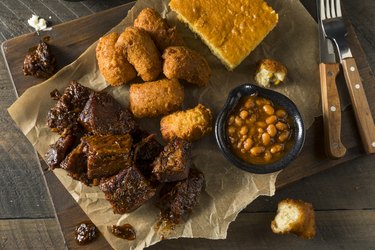
If you are from New England, you'll almost certainly be familiar with steak tips (sirloin tips), as they are hugely popular in that part of America. Backyard grilling is a favorite method for cooking steak tips, but you can successfully cook them indoors too.
Though definitions can vary, most of the time you'll be getting beef from the bottom part of the sirloin — the sirloin flap — when you buy steak tips. In regional, East Coast terminology, "tips" are this part cut into chunks.
Video of the Day
Video of the Day
Marinate Before Cooking Steak Tips
Before cooking steak tips, you are best to marinate them, as this adds succulence and a ton of flavor to the meat that, otherwise, could be quite tough.
If you're not sure where to start, this versatile marinade from the American Heart Association (AHA) works well with steak tips and other meats. Simply whisk together 3 tablespoons low-sodium soy sauce, two teaspoons vinegar and three minced garlic cloves; then whisk in a teaspoon of olive oil. Place in zip-top plastic bag with your steak tips and leave in the refrigerator.
Our Fresh Mango Marinade is another brilliant sauce for steak tips. The beef will benefit from several hours or overnight in the marinade to fully mop up the flavors.
As a bonus, the American Institute for Cancer Research (AICR) says that a marinade will reduce the formation of cancer-causing substances when meat is cooked at high heat by grilling, broiling or pan frying. The Academy of Nutrition and Dietetics advises that while it is marinating, meat should be kept in the fridge in a non-metallic container.
Cooking Steak Tips to Perfection
When you're ready to cook your marinated steak tips, preheat a skillet over high heat, adding a little bit of oil. Transfer the steak tips from the marinade to skillet and sear the outsides, then turn down to medium and continue to cook, turning over a few times with tongs to ensure even cooking.
Another option is to broil the steak tips, laying them out in a single layer on an oiled broiler pan or baking sheet around 3 inches away from the heat source.
Don't rely on just how the steak tips look to know when they are safe and ready to eat. The goal is to get the middle of the meat up to the minimum temperature consistent with food safety, which the U.S. Department of Health and Human Services advises is 145 degrees Fahrenheit. This way the steak tips will be safe to eat, while still being succulent.
Leftover marinade can be used as a sauce for steak tips. But if you do so, the Academy of Nutrition and Dietetics is very specific about the need to thoroughly boil any marinade that has been in contact with raw meat for food safety reasons.
Read more: How to Cook Sirloin Steak in an Oven
How Nutritious Are Steak Tips?
According to the USDA, 4 ounces of lean steak tips contain 9 grams of fat, of which a modest 3 grams is saturated fat (the type you should eat less of as it can raise cholesterol, according to the AHA). Don't forget that the marinade might add quite a lot of sugar and salt.
A 4-ounce portion contains 1.8 milligrams of anemia-protective iron, according to the USDA. That's 10 percent of the daily value as set by the Food and Drug Administration.
Read more: 4 Health Benefits of Eating Red Meat
However, you shouldn't eat red meat more than two or three times a week, as too much could increase your cancer risk. According to the AICR, the latest evidence suggests eating more than 18 ounces of red meat weekly increases the risk of colorectal cancer. And the National Cancer Institute says grilling red meat can add to its potential health downsides as it can also cause the formation of carcinogenic chemicals. Beef, lamb and pork are all red meats.
- American Institute for Cancer Research: "Mediterranean Marinades for Healthier Grilling"
- U.S. Department of Health & Human Services: "Safe Minimum Cooking Temperatures Charts"
- Academy of Nutrition and Dietetics: "How to Marinate Safely"
- USDA: "Lean Sirloin Tip Beef Steaks"
- American Heart Association: "The Skinny on Fats"
- Food and Drug Administration: "Vitamins and Mineral Chart"
- American Institute for Cancer Research: "Red and Processed Meats"
- National Cancer Institute: "What Are Heterocyclic Amines and Polycyclic Aromatic Hydrocarbons, and How Are They Formed in Cooked Meats?"
- American Heart Association: "Healthy Marinating and Grilling"